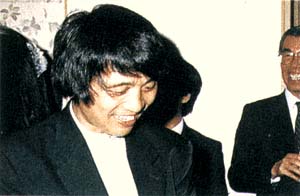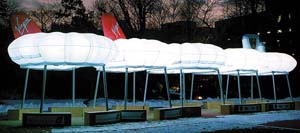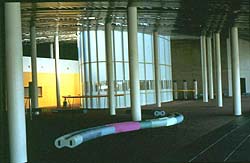L'edicola digitale delle riviste italiane di arte e cultura contemporanea
Intervista (1999 - 2000) Anno IV Numero 23 Summer/Estate 2000
Klein-Dytham
Inokuchi Natsumi
Rigorous fun (italiano - english)

Damien Hirst
Gemma De Cruz
n. 23 Summer/Estate 2000
Ugo Rondinone
n. 21 Gennaio-Febbraio 2000
Production of Production
Tim Griffin e Bennett Simpson
n. 21 Gennaio-Febbraio 2000
Maurizio Cattelan
Maurizio Cattelan
n. 21 Gennaio-Febbraio 2000
Matthew Barney
Richard Flood
n. 20 Ottobre-Novembre 1999
Francis Bacon
Michael Peppiat
n. 19 Estate 1999



Se siete gelosi di qualcosa probabilmente state pensando di essere in qualche modo capaci di ottenere la cosa che vi rende invidiosi. Se si tratta di una cosa che va oltre le vostre possibilità o al di là della vostra immaginazione, l'ammirazione prenderà il posto della invidia. Su queste basi possiamo dire che i lavori di Klein e Dytham, vi renderanno invidiosi.
La loro esperienza è nuovissima in Giappone, dove il noto architetto Tadao Ando è diventato famoso per il suo stoico approccio al trattamento dei materiali, accomunato a un contesto architettonico in armonia con la natura, sempre diretto
verso la perfezione e la precisione. Lo stesso vale per la sensibilità delle forme di Toyo Ito e la filosofia ambientalista del padiglione di carta di Shigeru Ban a Vancouver.
Sono esperienze troppo uniche e grandiose per esserne invidiosi. I lavori di K&D, invece, spaziano dalla grafica dei biglietti da visita alle pagine web, bottiglie di birra, mobili e cartelloni pubblicitari. Gli edifici poi, sono tutta un'altra cosa.
Di fronte ai loro prodotti potreste pensare all'architettura o addirittura di essere in grado di fare le stesse cose, visto che ricordano oggetti che potreste trovare dappertutto in mezzo alla strada. Ma se provate ad andarci vicino, vi renderete conto di non averli veramente assimilati.
I due fondatori di K&D, Mark Dytham e Astrid Klein http://www.klein-dytham.com/, sono arrivati in Giappone nel 1998 per un soggiorno di tre settimane, dopo aver terminato gli studi di architettura a Londra, ma trovarono la cultura del luogo
troppo affascinante per poterla conoscere in così poco tempo.
Quindi armati di portfolio e talento, visitarono diverse studi di architetti. Ed è stato presso lo studio di Toyo Ito che hanno dato inizio alla loro carriera in Giappone. Prolungato il loro soggiorno a undici anni, oggi dirigono un piccolo ufficio con altri tre soci, pronti a nuove scoperte, desiderosi di svilupparsi nel contesto metropolitano di Tokyo, città
di ispirazione e di realizzazione. La familiarità dei loro lavori è legata alla loro stessa esperienza, sembrano ancora divertirsi con la loro "leggera" curiosità per le cose wild e meravigliose che trovano in Giappone. Siano o meno easy going, questa è la percezione che un critico giapponese ha dato di loro: viaggiatori stranieri in vacanza in una paese orientale, che probabilmente un giorno torneranno in patria. Questo è probabilmente anche il punto di vista di altri critici del luogo, che difficilmente concepiscono l'architettura come piacere e lo humour che emerge ad ogni angolo e ogni strada, sette giorni su sette.
Basta visitare la loro web page, che è stata selezionata da Yahoo come sito dell'anno e che presenta i progetti e le scoperte in strada; oppure basta bere la Tokyo ale, la birra di cui hanno concepito il design, per essere già parte della loro esperienza architettonica: il loro messaggio è semplicemente quello di godersi la vita. Nel progettare un garage in un luogo limitato, alcuni architetti potrebbero vedere la cosa come una condizione restrittiva e si dedicherebbero a risolvere il
problema. K&D hanno invece un approccio diverso e osano esagerare lasciando addirittura che il paraurti tocchi il muro della casa del vicino. Il tetto a forma di macchina è ondulato, come se avesse subito un incidente.
Al di sotto della curva del tetto si trova lo spazio ampio con la collezione di super auto del cliente. La porta di ingresso che si affaccia sulla strada è piatta e discreta, gli elementi della linea del tetto non visibili. Queste tre facce creano un contrasto interessante nella costruzione singola del garage.
La maestosa sedia, "chu coo" è stata disegnata per NHK, il corrispettivo giapponese della BBC. La copertura in vinile lucido con ombre pastello e la fodera interna di velluto è una combinazione che probabilmente soddisfa sia l'immagine che l'orgoglio.
La familiarità che essi hanno con i materiali industriali si riflette anche nella loro capacità di utilizzarli per il design: pannelli Mow fatti con materiali riciclati dei cartelloni pubblicitari, metalli espansi per bidoni della spazzatura, poli carbonato e film colorati per facciate di edifici, lilos per pubblicità, ecc ecc.
"Pika Pika Pretzel", un cartellone gonfiabile su Omoteando, la strada più alla moda della città, ha attratto gli sguardi della gente per un paio di mesi. Il tessuto argenteo, brillante e dalla forma insolita ha fatto intasare le linee telefoniche
della società, a causa delle chiamate di curiosi che volevano sapere cosa fosse. La ragione di tanto seguito è che non si tratta di niente di intellettuale, ma di qualcosa di semplice e divertente, senza nessuna teoria architettonica particolare. Al momento, rimangono nella sfera dell'architettura d'interni o di progetti temporanei, fatta eccezione per due edifici completi. Sono attualmente interessati nella progettazione di un Love Hotel, una specie di nido d'amore per giovani.
Visto che gli hotel convenzionali sono stravaganti e pretenziosi, e intimidiscono le giovani coppie che vogliono entrarvi,
K&D vogliono creare un luogo più rilassato per i ragazzi fra i venti e i trenta anni. K&D dicono:"Lo stile, gli elementi distintivi e il problema del buono e del cattivo gusto, non sono presenti nel nostro lavoro". Quello che è chiaro è che hanno sempre gli occhi aperti per cercare ciò che è nuovo e provocatorio ("non possiamo farne a meno" dicono). In realtàdietro il loro divertimento vi è atteggiamento é peculiarmente rigido rispetto a quello che fanno. Il divertimento rigoroso è una cosa che nessuna teoria architettonica seria o metafora artistica può spiegare e che nessun imitatore può raggiungere.
Come dice Ito, loro creano con potenzialità fuori dell'"ordinario" cose mai viste prima in questa nazione. Alla fine sorge spontanea la domanda "perché il Giappone?". Più li si conosce, meno importante diventa questo aspetto, visto che la loro curiosità e la reazione all'ambiente circostante, non sono legati all'ambiente giapponese ma è semplicemente il frutto dell'istinto. Troverebbero ispirazione ovunque. In realtà hanno alcuni motivi per restare: in Giappone possono fare cose che non sarebbero possibili in altre nazioni. In Europa non ti è permesso di avere le tue ispirazioni naif e i tuoi innocenti desideri, perchè devi sempre prendere in considerazione il passato.
Sebbene tutto questo sia positivo, ora che hanno trovato il luogo dove possono creare e costruire quello che hanno disegnato, non sarebbe facile per loro ritornare a casa, sia spiritualmente che fisicamente. Come dicono loro stessi, rimarranno fino a
quando saranno annoiati del Giappone, ed entrambi dubitano che questo possa verificarsi un giorno.
If you're jealous of something, you probably think that somehow might be able to obtain the thing that is making you envious. If that was beyond your capabilities, on the other hand, or entirely different to what you could possibly imagine, you would have a kind of admiration for it rather than jealousy. On this basis, when the works of Klein Dytham Architecture come to this area they will make us jealous. This will be a novel experience in Japan, whereas a well-known architect such as Tadao
Ando has won respect for his stoic approach to material treatment, coupled with an architectural context in rapport with nature on each site, always aiming at precision and perfection. This is also true of Toyo Ito's sensibility to form or even
the environmental philosophy of Shigeru Ban's paper pavilion in Vancouver. They are too unique and grandiose to be jealous of. Works by KDa ranging from graphic designs such as name cards and web pages through to lager bottles, furniture, billboards and buildings are about something else. Looking at the products, you might feel that you could share the architects' ideas or even make the products themselves too, as they remind you of the everyday streets around you. Indeed if
you tried you'd get close, but then find you were not quite there after all. The two founders of KDa, Mark Dytham and Astrid Kein arrived in Japan in 1988 for a three-week tour after studying architecture in London, but found a culture too fascinating to deal with in such a short stay. So, with their portfolios in their hands, their wits about them, they visited several architectural firms. It was in Toyo Ito's they eventually initiated their career in Japan. Extending the trip to
an 11-year stay, today they run their small office with three other members ready for discoveries and growth in the metropolitan context of Tokyo, the city of inspiration and realisation. The familiarity in their works is due to the architects themselves, who appear tobe having fun with their easy going curiosity about the wild and wonderful things they find in this strange country, Japan. Whether or not they are actually being "easy-going", this was how one Japanese critic distantly perceived them. He worried that they were foreign travellers having a vacation in an exotic eastern country and were eventually set to return to their home in the West. This was probably the view of many other native critics, who have rarely seen architecture as a matter of the pleasure and humour that emerges from every corner of every street and fascinates you from Monday through Sunday. Visiting the web page that has been selected by Yahoo as the "Site of the Year" introducing
their projects and street discoveries, and drinking "Tokyo Ale", the lager designed by the architects, will already be a part of KDa architectural experience, the message being simply to enjoy your life. In designing a garage for a narrow site, some architects might see the condition as a problem and dedicate themselves to solving it. KDa take a different approach
and dare to exaggerate the situation letting the vehicle box bump against the back wall of the neighbouring house. The car-shaped roof waves due to the illusory collision. Below the shapely curve of the roof, is the bright void containing the
client's supercar collection. The entrance shutter facing the streets is flat and modest, the elements in the roof line
above unseen. These three faces create a pleasant contrasts in a single garage building.
The weighty rounded, "chu-coo chair" was designed for NHK, the Japanese counterpart of the BBC more or less, posh yet passé. The glossy vinyl cover with pastel shades and velvet cloth inside, is a combination that hopefully satisfies both the image and pride.
Familiarity with industrial materials is reflected in the confidence of their design. MOW panel made of recycled waste for billboards, expanded metal for rubbish cans, polycarbonate and coloured film for building facades, lilos for hoardings
etc. "Pika Pika Pretzel", an inflatable hoarding on Omotesando, the city's major fashion street, has been there for a couple of months catching peoples' startled eyes. Its shining silver fabric and eerie shape made them ring the office up asking
what it is all about. The response is that it is nothing too intellectual, something simply to have fun with as you feel like, no architectural theory, please. At the moment, they remain in the sphere of interiors and temporary projects, with the
exception of a few complete buildings. They are, however, interested in designing a "love hotel" complex, love nests for young couples escaping into.
Since conventional hotels are particularly extravagant and pretentious, making younger visitors wary of entering, the architects have come up with a rather more relaxed love for those in their 20s and 30s. Klein and Dytham say "Styles, signature elements, even the question of good or bad taste are not present in our process." What is evident in KDa is their
wide-open eyes constantly searching for anything new and provocative. "We can't help it". In fact, while they are having such fun their attitude is peculiarly rigid in doing so. This rigorous fun is what any "serious" architectural theory or artistic metaphor could hardly explain and is what an imitator could never reach. As Toyo Ito says, they bring "outstanding wit" previously unseen in this country. In the end to ask them "why Japan?" might be a banal question. The better you know them, the less important it becomes, since their curiosity and response to their surroundings are not particularly tied to the
Japanese environment but simply instinctive. They would find inspiration wherever they might end up. Still, they do have some
reasons for staying; in Japan they can do what they could hardly do in their countries. Usually in Europe, you would not be allowed to have your naive inspirations and innocent desires actually built, but would be expected to preserve and take care of the ancient ruins. Though that is all very well, now that they have happened to find a place where they can create and actually build their designs, it would not be easy for them to go home, both mentally and practically. As they always remark, they will stay until they get bored with the country. And they both doubt that time will ever come.
Inokuchi Natsumi
Mark Dytham and Astrid Klein live and work in Tokyo.


